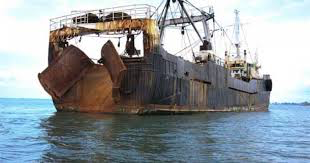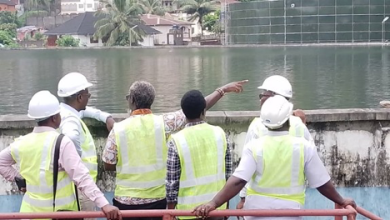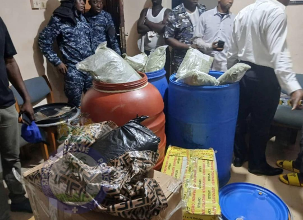Ghost Ships Of Sierra Leone

By Lansana Kotor-Kamara Esq.
A few weeks ago, I visited Uncle Tom at his residence in Juba. He is a man whose life has been intertwined with the sea, over thirty years in the fisheries industry before retirement, and a deep understanding of maritime operations. We spoke about international politics, the perilous state of the Kabala-Makeni highway, and my recent analysis of the Trump Gaza 20-point peace plan. Suddenly, the conversation shifted.
Leaning forward, his eyes sharp, he asked, “Lansana, I went for my morning walk along Lumley Beach. There are wrecked vessels along the shore. Since you are a maritime lawyer, what can be done about them?”
I hesitated. “Wrecked vessels? Are you certain?”
“Yes,” he replied, his voice steady. “Abandoned. Rusting. No names. No crews. No flags. It’s… unsettling.”
The question struck me like lightning. I could not dismiss him, nor deny the need to see the wrecks for myself. After a quick meal of Banga soup with fish, I set out toward Lumley Beach, my mind racing. Initially, it seemed like rumor, the kind of maritime tale that grows with every telling but soon the evidence was undeniable. Broken, rusting boats lay stranded like corpses along our coastline. Two at Lumley Beach, one hauntingly in front of the famous Chapter One nightclub. Others were reported near Banana Island. More recently, wrecks appeared around Sulima and Bonthe Island. They arrived silently, disappeared just as silently.
No official reports. No public statements. Not a word from the authorities. Most would dismiss this as coincidence or bad weather. But as someone who holds an LLM in international maritime law from the International Maritime Law Institute, Malta, has worked with the Sierra Leone Ports Authority and Sierra Leone Maritime Administration, and conducted extensive research on maritime security, shipping law, and ocean governance, I knew this was far more than rumor. When unregistered vessels drift onto your shores unchallenged, your coastline ceases to be a border, it becomes a corridor for crime.
The following morning, I walked along the sand at Lumley Beach. A wreck leaned precariously on the shore, corroded and reeking of diesel. Children kicked a football nearby, oblivious to the vessel’s potential cargo, narcotics, weapons, toxic waste, or even mercenaries. The sea keeps its secrets well. But when the state does not ask, it grants those secrets safe passage.
Across West Africa, ghost ships have been linked to human trafficking, arms smuggling, illegal fuel, and toxic waste dumping. Now Sierra Leone faces the same pattern: abandoned vessels, vanished crews, illicit cargo unchecked. Each hull is a potential crime scene. Some crews flee after offloading contraband. Others transport desperate migrants, or mercenaries. Toxic waste has been deliberately dumped under cover of darkness in neighboring countries. Each wreck on our shores is a warning: someone knows our vulnerabilities better than we do.
Our legal obligations are clear. Under the United Nations Convention on the Law of the Sea (UNCLOS), Sierra Leone must exercise vigilance in its territorial waters to protect safety, security, and law enforcement. The Nairobi International Convention on the Removal of Wrecks obliges coastal states to locate, mark, and remove hazardous wrecks to prevent environmental and navigational hazards. Domestically, Part XII of the Merchant Shipping Act of Sierra Leone explicitly empowers the government to manage wrecks, authorizing marking, removal, and disposal of derelict or abandoned vessels, as well as enforcement against owners or operators who fail to comply. Failure to act under these provisions is not bureaucratic oversight, it is a direct threat to sovereignty, national security, and public safety.
The environmental danger is immense. Fuel and chemicals leach into sand and reefs. Fish breeding grounds are poisoned. Coastal ecosystems, already fragile, face long-term degradation. But the greater peril is invisible: drugs, weapons, mercenaries, toxic waste, all arriving quietly, unchecked. Our maritime surveillance is fragmented. Coordination between the Navy, Ports Authority, and Maritime Administration is minimal. We rely too heavily on reactive, foreign monitoring systems. This is a disaster waiting to unfold.
“These wrecks… they’re not accidents, are they?” I asked Uncle Tom later that day, after returning from the beach.
“No,” he said, shaking his head. “This is deliberate. Someone is testing our waters. If we ignore this, it could become a catastrophe, environmental, criminal, and strategic. Sierra Leone cannot afford to look away.”
These wrecks are not accidents. They are warnings. The ocean speaks, in the language of rust, decay, and vanished crews. Our sovereignty is eroding. Our security is compromised. Every abandoned vessel is proof that our coastal defenses are asleep.
Action is imperative. Every wreck must be investigated. Ownership traced. Origins identified. Findings must be published. A national coastal monitoring force must combine modern surveillance with local intelligence, especially from fishermen, our living radar. Our coastline is not merely land by the sea; it is our lifeline: trade, food, identity.
If we continue to ignore these signals, we will lose control piece by piece, tide by tide. The ghosts of these ships are not metal and rust, they are the embodiment of our inaction, a national disaster unfolding silently before our eyes.
The question is no longer whether these vessels are a coincidence. The question is whether Sierra Leone will wake up before the next one drifts ashore and what it will cost if we do not.





